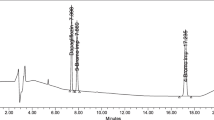Abstract
A simple and accurate UHPLC method was developed for Dabigatran etexilate (DAB) using Acquity CSH C18 (100 mm × 2.1 mm × 1.7 µm) column with mobile phase containing ammonium acetate (pH 5.0) and methanol in gradient program. This method was used to study the forced degradation products of DAB. The drug was found to degrade in all hydrolytic and oxidative conditions resulting in formation of four major degradation products (DP1 to DP4). DAB and its degradation products were well separated using the proposed method. The degradation products were characterized using LC-Q-TOF/ESI/MS/MS and accurate mass measurements for obtaining the structural information. The degradation pathway leading to the formation of the degradation products was also proposed. In silico tools like TOPKAT and DEREK software were used to evaluate the toxicity associated with DAB and its degradation products. The developed method was validated as per ICH Q2 (R1) guidelines. The method showed linear response over a concentration range of 45–105 µg mL−1 with correlation coefficient of 0.9998. The accuracy of the method was observed within the acceptable limits of 98–102 %. The precision of the method was good as indicated by %RSD values less than 1.0. The proposed method was found to be robust when deliberate changes were made in pH of buffer, column temperature and flow rate of the mobile phase. The developed method finds its application as a stability indicating assay method for the determination of DAB.




Similar content being viewed by others
References
Van Ryn J, Stangier J, Haertter S, Liesenfeld K-H, Wienen W, Feuring M, Clemens A (2010) Thromb Haemost 103:1116
Holmes M, Carroll C, Papaioannou D (2012) Pharmacoeconomics 30:137–146
Larsen TB, Rasmussen LH, Skjøth F, Due KM, Callréus T, Rosenzweig M, Lip GY (2013) J Am Coll Cardiol 61:2264–2273
Hankey GJ, Eikelboom JW (2011) Circulation 123:1436–1450
Prajapati A, Kumar S, Sen AK, Zanwar A, Seth A (2014) Pharma Sci Monit 5:31–35
Bernardi RM, Fröehlich PE, Bergold AM (2013) J AOAC Int 96:37–41
Damle MC, Bagwe RA (2014) J Adv Sci Res 5:39–44
Reddy MBS, Rao NVB (2014) South Pac J Pharm Bio Sci 2:80–92
Hu Z-Y, Parker RB, Herring VL, Laizure SC (2013) Anal Bioanal Chem 405:1695–1704
Delavenne X, Moracchini J, Laporte S, Mismetti P, Basset T (2012) J Pharm Biomed Anal 58:152–156
Bernardi RM, D’Avila FB, Todeschini V, Andrade JM, Fröehlicha PE, Bergolda AM (2015) J Braz Chem Soc 26:660–666
ICH guideline (2003) Q1A (R2) stability testing of new drug substances and products. In: International Conference on Harmonisation, IFPMA, Geneva
ICH guideline (1996) Q1B photostability testing of new drug substances and products. In: International Conference on Harmonisation, IFPMA, Geneva
Singh S, Handa T, Narayanam M, Sahu A, Junwal M, Shah RP (2012) J Pharm Biomed Anal 69:148–173
Bakshi M, Singh S (2002) J Pharm Biomed Anal 28:1011–1040
Snyder RD, Pearl GS, Mandakas G, Choy WN, Goodsaid F, Rosenblum I (2004) Environ Mol Mutagen 43:143–158
Dearden JC (2003) J Comput Aided Mol Des 17:119–127
Acknowledgments
The authors wish to thank Dr. Ahmed Kamal, Project Director, National Institute of Pharmaceutical Education and Research (NIPER), Hyderabad for his constant encouragement. The authors are thankful to Department of Pharmaceuticals, Ministry of Chemicals and Fertilizers, New Delhi, India for providing research fellowship.
Author information
Authors and Affiliations
Corresponding author
Additional information
D. Swain and P. N. Patel contributed equally to this work.
Rights and permissions
About this article
Cite this article
Swain, D., Patel, P.N., Nagaraj, G. et al. Liquid Chromatographic Method Development for Forced Degradation Products of Dabigatran Etexilate: Characterisation and In Silico Toxicity Evaluation. Chromatographia 79, 169–178 (2016). https://doi.org/10.1007/s10337-015-3009-5
Received:
Revised:
Accepted:
Published:
Issue Date:
DOI: https://doi.org/10.1007/s10337-015-3009-5




